| Srl | Item |
| 1 |
ID:
174623
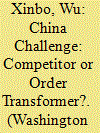

|
|
|
|
|
| Summary/Abstract |
There is no question that the sudden outbreak of the coronavirus and the heavy causalities it has brought to the United States have led to an unhealthy and even dangerous path toward heightened antagonism in Sino-US relations. The friction between Beijing and Washington over COVID-19, however, may have also overshadowed some more fundamental elements underlying their interactions that will continue to shape bilateral ties and even international systemic mega-trends, long after the current crisis. In fact, the ongoing discourse on the implications of the pandemic has already raised questions about how it may affect strategic competition, a potential power shift between the United States and China, and even international order in general. It is, therefore, highly important to have a sober and systemic assessment of the drivers and momentums that have been molding US-China relations to understand the relationship’s future, during and after the COVID-19 crisis.
|
|
|
|
|
|
|
|
|
|
|
|
|
|
|
|
| 2 |
ID:
174627


|
|
|
|
|
| Summary/Abstract |
The threat of nuclear war appears to be growing as we enter the third decade of the 21st century. Washington and Moscow, which together hold over 90 percent of the world’s nuclear weapons, are gradually discarding the international agreements designed to structurally reduce and limit their nuclear force postures. 1 The recent US withdrawal from the bilateral 1987 Intermediate-Range Nuclear Forces (INF) Treaty, following Russian violations, now permits these states to begin constructing and fielding previously banned ground-launched ballistic and cruise missiles with ranges between 500 and 5,500 kilometers.
|
|
|
|
|
|
|
|
|
|
|
|
|
|
|
|
| 3 |
ID:
174624


|
|
|
|
|
| Summary/Abstract |
On May 15, 1984, the countries in Europe had largely managed to remain at peace with each other for the longest continuous stretch of time since the days of the Roman Empire. 1 That rather amazing record has been further extended—by now, the continent may well be experiencing the longest period (75 years) free from substantial interstate war since Europe itself was invented as a concept some 2,500 years ago.
|
|
|
|
|
|
|
|
|
|
|
|
|
|
|
|
| 4 |
ID:
174619


|
|
|
|
|
| Summary/Abstract |
President Trump has routinely touted the foreign policy benefits of unpredictability. As candidate Trump complained about the US administration in 2016, “We are totally predictable. We tell everything. We’re sending troops? We tell them. We’re sending something else? We have a news conference.
|
|
|
|
|
|
|
|
|
|
|
|
|
|
|
|
| 5 |
ID:
174622
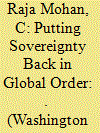

|
|
|
|
|
| Summary/Abstract |
Irrespective of who wins the US presidential elections in November, the next administration in Washington will have to confront major structural changes in the international system and cope with profound internal instability. The world faces a powerful backlash against hyper globalization—in both economic and security domains—that came to define the post-1991 era
|
|
|
|
|
|
|
|
|
|
|
|
|
|
|
|
| 6 |
ID:
174620


|
|
|
|
|
| Summary/Abstract |
In 2016 and 2017, North Korea demonstrated a range of technologies that brought it much closer to deploying an intercontinental ballistic missile (ICBM). After the November 2017 test of the Hwasong-15 missile, Kim Jong Un declared that North Korea has “finally realized the great historic cause of completing the state nuclear force” and is now immune to American nuclear blackmail and coercion.
|
|
|
|
|
|
|
|
|
|
|
|
|
|
|
|
| 7 |
ID:
174618
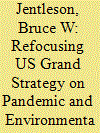

|
|
|
|
|
| Summary/Abstract |
Amidst all the criticisms of the Trump foreign policy, one aspect that has received substantial praise has been the emphasis on great power competition. “After being dismissed as a phenomenon of an earlier century, great power competition returned,” the 2017 National Security Strategy declared. “Long-term strategic competitions with China and Russia are the principal priorities for the [Defense] Department,” the 2018 National Defense Strategy affirmed.
|
|
|
|
|
|
|
|
|
|
|
|
|
|
|
|
| 8 |
ID:
174625


|
|
|
|
|
| Summary/Abstract |
Where is nuclear arms control—negotiated restraints on the deadliest weapons of mass destruction—headed? This 50-year tool of US national security policy is currently under attack. The New Strategic Arms Reduction Treaty (New START), the last remaining nuclear arms agreement with the Russian Federation, will go out of force in February 2021 unless it is extended for an additional five years as the treaty permits. At this moment, nothing is on the horizon to replace it, though the Trump administration has promised a new and more extensive agreement that includes China as well as Russia. The negotiators have scant time to finish such a treaty before New START ends.
|
|
|
|
|
|
|
|
|
|
|
|
|
|
|
|
| 9 |
ID:
174626
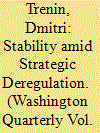

|
|
|
|
|
| Summary/Abstract |
That nuclear arms control is on the way out is no news. The unraveling of its Cold War-era architecture started almost two decades ago, when US President George W. Bush welcomed Vladimir Putin to his ranch at Crawford, Texas and told the then-young Russian leader that he intended to withdraw from the Anti-Ballistic Missile (ABM) Treaty. The withdrawal from this 1972 treaty, which placed severe restrictions on both countries’ strategic defenses, was a severe blow to the Russians, who had long considered it a cornerstone of strategic stability. Bush, however, couldn’t care less. The Cold War was over, and several countries around the world were busy developing ballistic missiles that required US response. Russia was neither an adversary nor a close partner of the United States, and it was lying flat on its back. While Washington was pointing to North Korean and Iranian missile programs, Moscow suspected it was seeking strategic superiority over both Russia and China.
|
|
|
|
|
|
|
|
|
|
|
|
|
|
|
|
| 10 |
ID:
174621
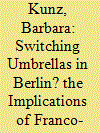

|
|
|
|
|
| Summary/Abstract |
In light of increasing doubts about US security guarantees, the idea of a greater role for the French nuclear deterrent in European security has gained a certain amount of traction, including among German politicians and citizens.
|
|
|
|
|
|
|
|
|
|
|
|
|
|
|
|